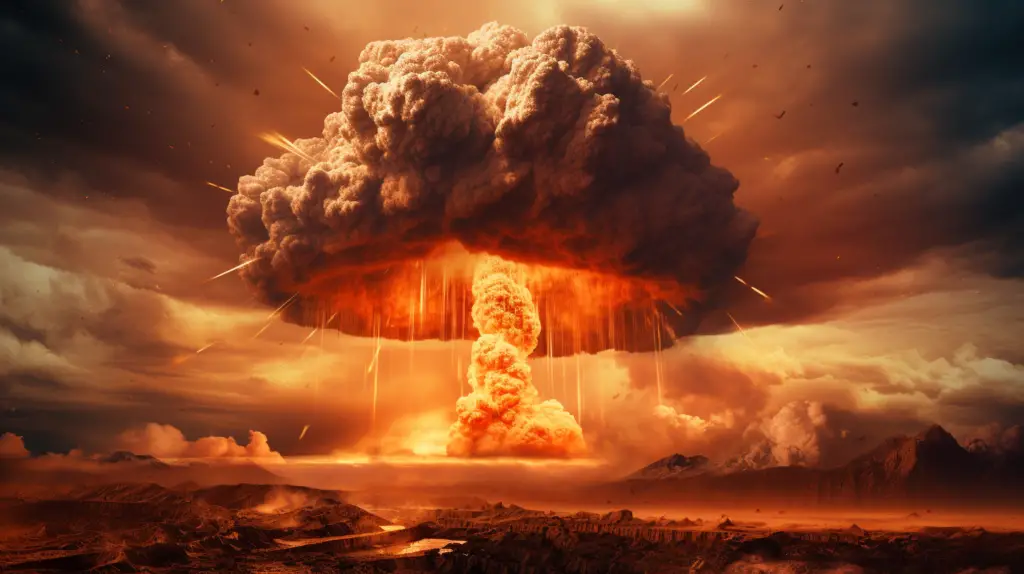The creation of the atomic bomb ushered the world in the Atomic Age. Stemming from breakthroughs in physics, the concept took tangible form under the Manhattan Project during World War II. Initiated due to fears of Nazi Germany developing such a weapon, the project enlisted some of the era’s most brilliant minds, including J. Robert Oppenheimer, Enrico Fermi, and Niels Bohr. Their collective effort resulted in two variants of atomic bombs by 1945: the uranium-based “Little Boy,” dropped on Hiroshima, and the plutonium-based “Fat Man,” used on Nagasaki. This remarkable scientific achievement showed the immense potential and catastrophic peril of nuclear technology.

In this article I will present 50 important things you need to know and understand about the atomic bomb.
- The atomic bomb was created during World War II, as part of the Manhattan Project.
- The Manhattan Project cost over 2 billion dollars at the time, the equivalent of 26 billion dollars today.
- The first atomic bomb was detonated on July 16, 1945, in the desert of New Mexico, USA, in a test known as “Trinity”.
- The atomic bomb is powered by nuclear reactions, either fission (breakdown of atoms) or fusion (combination of atoms).
- The bomb at Hiroshima, known as “Little Boy”, had a yield of about 15 kilotons of TNT.
- The bomb at Nagasaki, named “Fat Man“, had a yield of 21 kilotons of TNT.
- Just over 0.6 grams of matter were converted into energy in the explosion of the Hiroshima bomb.
- At the moment of detonation, the temperature at the center of the atomic bomb explosion can reach millions of degrees Celsius, much hotter than the sun.
- The atomic bomb produces three main forms of radiation: alpha, beta, and gamma.
- Nuclear radiation can cause radiation sickness, which can be fatal.
READ MORE: 50 facts you need to know and understand about the atomic bomb dropped on Hiroshima - The atomic bomb also produces an electromagnetic pulse that can destroy electrical devices.
- The explosion of the atomic bomb produces an atomic mushroom, a tall cloud that forms due to the explosion.
- The atomic bomb at Hiroshima killed approximately 140,000 people, and the one at Nagasaki killed approximately 70,000 Japanese.
- The long-term effects of radiation caused many deaths and illnesses in the years following the bombings.
- Some survivors of the atomic bombings, known in Japan as “hibakusha”, are still living.
- An atomic bomb can cause long-term damage to the environment, including radioactive contamination and ecological degradation.
- In 1961, the USSR detonated the largest atomic bomb in history, known as the “Tsar Bomba”. It had a power of 50 megatons of TNT.
- Although the “Tsar Bomba” was almost 4,000 times more powerful than the Hiroshima bomb, it was actually designed to be twice as powerful.
- Atomic bombs are measured in kilotons (KT) or megatons (MT) of TNT.
- The United States and Russia hold the majority of the global nuclear arsenal.
READ MORE: 50 facts you need to know and understand about the atomic bomb dropped on Nagasaki - “Nuclear arsenal” refers to the total number of nuclear weapons a country possesses.
- Since the end of the Cold War, the number of nuclear weapons in the world has significantly decreased.
- However, even a single atomic bomb can cause immense damage.
- An atomic bomb could cause a nuclear winter, a theory that dust and smoke raised into the atmosphere by nuclear explosions could block sunlight and cool the planet.
- The atomic bomb was the only weapon of mass destruction used in war.
- Even more than 78 years after the initial use of the atomic bomb, nuclear disarmament remains a major global goal.
- There are international treaties, such as the Nuclear Non-Proliferation Treaty, intended to prevent the spread of nuclear weapons.
- Despite these treaties, some countries, such as North Korea, have developed their own nuclear weapons.
- There are international organizations, such as the International Atomic Energy Agency, that monitor the use of nuclear energy and try to prevent the proliferation of nuclear weapons.
- Some people argue that the threat of nuclear weapons helped maintain peace during the Cold War, a concept known as “nuclear deterrence”.
READ MORE: Who was SADAKO SASAKI and her 1000 PAPER CRANES? - Others argue that the risk of a nuclear war makes any possible benefit of nuclear weapons unworthy.
- The atomic bomb has had a significant impact on popular culture, appearing in movies, books, and video games.
- There is a wide variety of types of nuclear weapons, from simple atomic bombs to much more powerful hydrogen bombs.
- While the atomic bomb uses nuclear fission, the hydrogen bomb uses both fission and nuclear fusion.
- The hydrogen bomb, or thermonuclear bomb, is many times more powerful than a traditional atomic bomb.
- The development of the hydrogen bomb was a key element of the nuclear arms race during the Cold War.
- Despite their names, “Little Boy” and “Fat Man” were not actually small. “Little Boy” was approximately 4,400 kg, and “Fat Man” was about 4,670 kg.
- Many of the consequences of nuclear radiation are not immediate and may only appear after weeks, months, or even years.
- Nuclear radiation can cause genetic mutations that can be passed from one generation to another.
- After the bombings at Hiroshima and Nagasaki, many victims suffered from what is now known as “radiation sickness”.
READ MORE: Top 10 Japan Culture Shocks | All You Need To Know - Warning signs of nuclear radiation include nausea, vomiting, weakness, and hair loss.
- Survivors of nuclear bombs can suffer from long-term health problems, such as cancer and leukemia.
- Nuclear bombings caused significant damage to structures and infrastructure, leaving the cities of Hiroshima and Nagasaki virtually destroyed.
- While “Little Boy” and “Fat Man” are the best-known atomic bombs, many other nuclear tests have taken place over the years.
- Nuclear tests can have significant environmental consequences, including radioactive contamination and degradation of natural habitats.
- Some modern atomic bombs can be over 1,000 times more powerful than those used at Hiroshima and Nagasaki.
- The atomic bomb led to the development of peaceful nuclear technologies, such as nuclear power plants.
- Despite their risks, nuclear weapons continue to play a significant role in the military and political strategy of many countries.
- There is still a large number of nuclear weapons in the world, with estimates of over 13,000 in total.
- Many people and organizations are working towards a future without nuclear weapons, hoping to prevent any future use of them.
READ MORE: 25 Interesting Facts About “Hibakusha”: Survivors of the Atomic Bombings
Watch the video presentation:
The atomic bomb represents a significant chapter in human history, a tangible manifestation of scientific achievement and an ominous symbol of destruction. Its development during the mid-20th century irrevocably altered the course of global politics and warfare, casting a long and shadowy specter over the world with the potential for unprecedented devastation. Yet, it also underscores the imperative for international cooperation, diplomacy, disarmament, and a shared commitment to peace. As we continue to grapple with its implications, the atomic bomb serves as a stark reminder of the vast power science can yield, urging us to continually question how we should apply such power to ensure a safe and secure future for all.


